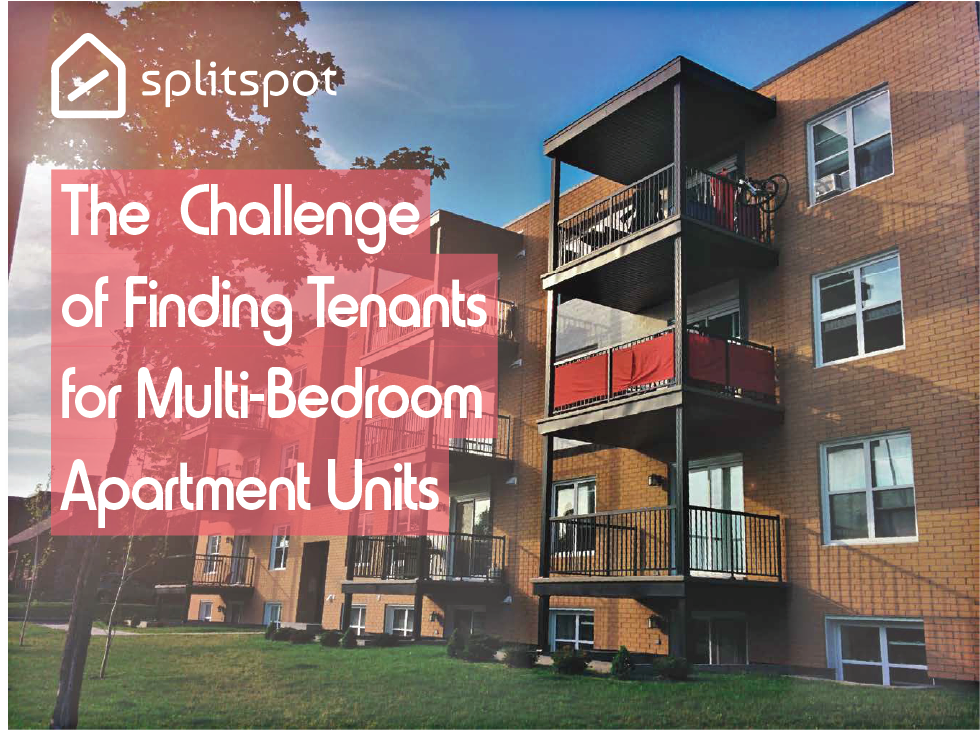And what landlords can do to make it easier
Filling a vacancy in a studio or one bedroom apartment is often pretty straightforward. Find an individual (or a couple) that likes the location and makeup of your space, and they’re signing a lease in no time.
Things can get a little more complicated when there’s more bedrooms – and renters – in the mix. More rooms mean more personalities, priorities, and people: increasing the chance that there’s a hitch in an otherwise harmonious leasing agreement.
Research firm Axiometrics found that roughly 46% of the apartment market is made up of multi-bedroom apartments (read: anything with more than one bedroom). Landlords will likely spend more than half their time filling these units, even if they make up a proportionally smaller chunk of the apartment landscape.
Let’s investigate what makes filling these larger apartments more difficult – and explore a solution to any multi-bed migraines.
Limited Renter Pool

The demand for studios and one beds is rising for a variety of reasons: one of them being increased debt amongst college grads and Millennials starting families at a later age. These young professionals might not be buying houses in their late 20s, but they do prefer to live without roommates. That makes studios and one-beds hot commodities.
Families make great fits for multi-bedroom apartments. However, they might be more likely to opt for a long-term solution. Let’s take the rental market in Boston, for example. The average monthly cost of a studio is $1,711 compared to $3,653 for a four-bedroom apartment. This makes sense – more space means a higher cost.
Consider, however, that the average monthly mortgage payment in Massachusetts is $2,165. While a solo renter might remain in the apartment game given this higher cost, a family may decide they are better off building equity in a home they own.
If fewer families are opting for these multi-bedroom units, then that leaves rooming groups as the alternative leasing option. Non-related renting groups may form with a desire to save on a per-room basis, have a home-based community, or otherwise, but placing them and keeping them in multi-bedroom units are increasingly challenging.
Increased Need for Flexibility
The COVID-19 pandemic (and corresponding surge in remote work) has spurred many renters to prefer flexibility in their housing situations. In New York City, short-term or month-to-month leases increased by 70% from 2019 to 2020.
Renters are gravitating towards living situations with more flexibility, rather than rushing to sign up for 12-month leases that start on September 1st. When you’re tied to a large group in a multi-bed, that flexibility is even more difficult to achieve. The days of multi-roommate groups intentionally signing up for a long-term lease together might be fading.
Competing Priorities and Personas
There’s also a human element that goes beyond the basic math problem of multi-bed spots.
Finding a perfectly packaged group of renters that fits into the requisite number of bedrooms isn’t always easy. Different renters have different “renter personas”: each individual may have different priorities when searching for a place to live.
Some renters care most about who they’re living with. They have a general criteria on their ideal apartment, but want to find a place with their pre-selected roommates (think: a group of friends from college).
Other renters care most about the apartment itself (the layout, the location) and will go to places like Facebook and Craigslist to find roommates after picking their perfect space. When they ultimately find their ideal apartment, they may not be able to find enough roommates to split the cost and afford the space. And even if they do find roommates, getting them aligned on priorities and timing is another challenge on top of that. These difficulties can push renters away from multi-beds.
Bottom-line is that given all these competing priorities and personas, it’s typically much harder to package up and place an ideal rooming group than slot in an individual into a studio or 1-bedroom.
How SplitSpot Solves This Problem
SplitSpot is a flex-lease room rental platform that’s making life easier for landlords and tenants alike. We’ve rented hundreds of units and post extremely high occupancy at above-market rates.
Our platform provides renters with the flexibility they prefer – rolling leases, low up-front costs, pre-vetted roommates and more. Partnering with SplitSpot transforms your multi-bed vacancies into unique commodities that appeal to renters’ wants and needs. Additionally, your vacancies get more visibility during off-cycle or down-market conditions. In a way, SplitSpot turns your multi-bed units into single-bed units – making them easier and more profitable to lease, while providing a service and product that stands out to the modern renter.
In addition to filling rooms, we also offer ancillary benefits like streamlined communication and triaging on maintenance issues – meaning you don’t have to be on guard 24/7 and only have to respond to real issues.
Sign up to see if your units qualify and take a step towards partnering with SplitSpot. Your multi-bed migraines could be a thing of the past.
